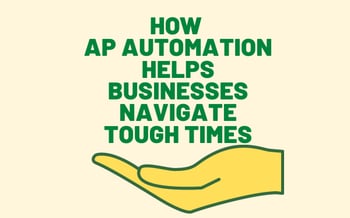How JD Edwards AP Automation Help Businesses Navigate Tough Times
How JD Edwards AP Automation Help Businesses Navigate Tough Times
Canon Information & Imaging Solutions, Inc.
It has been a tough year for businesses. But for many businesses, the toughest test lies ahead:
How to return to growth in a challenging economic environment
This is the time to rethink the way your business operates. Those who step up their game will be better off and far more ready to confront the challenges and opportunities of the new normal.
One area that businesses should take a hard look at is their JD Edwards AP Automation.
Accounts payable can play a big role in helping the business navigate turbulent times. And automation can help set the business on a course for long-term success when things improve.
Many businesses already have begun to rethink the way they pay their suppliers using JD Edwards.
Before the pandemic, 41 percent of businesses made at least half of their payments to supplier via a paper check, according to the results of a poll conducted during a recent Institute of Finance and Management (IOFM) virtual town meeting. The smaller your business, the higher the percentage of check payments you were likely to have made to suppliers before the pandemic began.
Since the start of the pandemic, the percentage of businesses that make at least half of their payments to suppliers by check has declined by an astounding 7 percentage points, IOFM’s poll found.
If you think that is impressive, consider this:
Before the pandemic, none of the businesses surveyed by IOFM made all their payments electronically. At least some of their supplier payments were made with a paper check.
Since the pandemic started, 3 percent of businesses now make all their payments electronically.
Over the past four-and-a-half months, businesses have made more progress in migrating away from paper check payments to suppliers than they made in the previous four-and-a-half years.
Admittedly, some businesses had no choice but to migrate to electronic payments during the pandemic. It was not safe, or legal, for employees in some states to come into the office to cut checks. But there are a lot of other reasons that businesses are migrating to electronic payments. Compared to paper checks, electronic payments are cheaper, less risky, more efficient, and faster.
IOFM’s poll did not address what has happened with the volume of paper invoices that accounts payable departments process. But it is safe to assume that something similar is happening. After all, 71 percent of businesses plan to automate their accounts payable function further in 2020, according to another online poll conducted by IOFM during a virtual town hall meeting of payables leaders.
Even departments that are largely automated have plans to deploy more technology. Only 6 percent of departments have thrown in the towel and say they will not budge from their manual processes.
The push towards accounts payable automation is long overdue.
• Only 9 percent of accounts payable departments are fully automated, IOFM reports.
• Fourteen percent of accounts payable departments operate completely manually.
• Six percent of accounts payable departments have little automation.
• The approaches to invoice processing that many departments used during the pandemic – working longer hours, routing invoices via e-mail, and sending staff into the office once a week to scan mail into an e-mail box for routing and approval – are not sustainable.
Digitizing accounts payable helps businesses gain back time, money, and control, at a time when they need all three the most – all while extending investments in JD Edwards and other ERP and accounting systems.
In turbulent times, no one has the time for manual invoice processing.
When it comes to invoice processing, businesses are bogged down by an endless list of manual tasks, all the while, trying to comply with dozens of business rules, best practices, regulations, and auditor guidelines. And accounts payable leaders are now doing all this in a remote working environment.
Eighty-four percent of the typical accounts payable professional’s time is spent on manual tasks. In fact, payables leaders often spend more time on heads-down transaction processing than on the managerial tasks they were hired for. No wonder accounts payable is seen as a drain on resources.
The challenge for accounts payable departments will be to use the lessons learned from their Work from Home experience during the pandemic to achieve sustainable results during the new normal.
Accounts payable must modernize
The C-Suite may argue that now is the time to hoard cash, not invest in automation.
There is no question that a strong cash position is critical to an organization’s survival.
But the right accounts payable solution can provide the visibility necessary to improve cashflow, while delivering tantalizing operations improvements. And many accounts payable solutions can be up and running quickly with minimal upfront costs, providing a fast return on investment (ROI).
For instance, an automated accounts payable solution puts cash controls at your fingertips. Real-time data around crucial business metrics informs and accelerates decision-making. Finance leaders can leverage accounts payable data to quickly model financial plans that reflect changing scenarios. And real-time visibility into all supplier expenses helps senior management stay on top of spending.
But that is not all. Accounts payable automation also provides a business with the tools it needs for:
• Revenue growth
• Profitability
• Mitigating risk
In the weeks ahead, businesses will begin to develop strategies for returning to growth. With automation, accounts payable departments can help guide them. Let us show you how with JDE AP Automation.
FOR MORE INFORMATION ON JD EDWARDS 9.2.4 OR GSI'S JD EDWARDS SERVICE OFFERINGS
CONTACT US TODAY
FOR MORE INFORMATION ON JDE 9.2.4 OR GSI'S JD EDWARDS SERVICES
